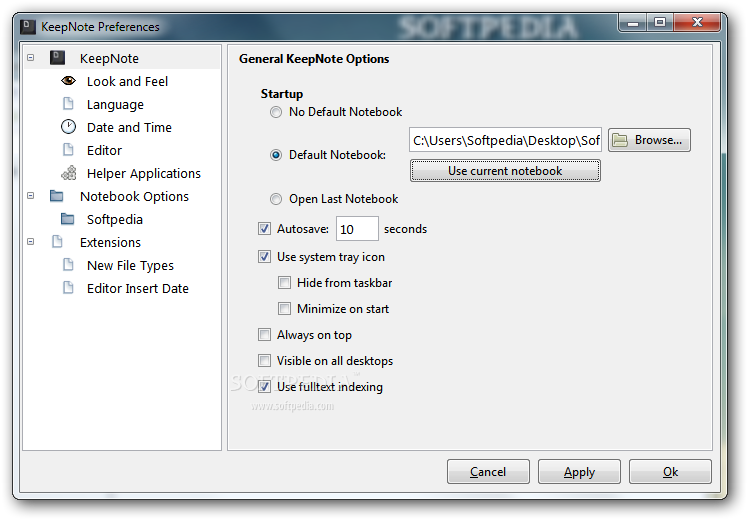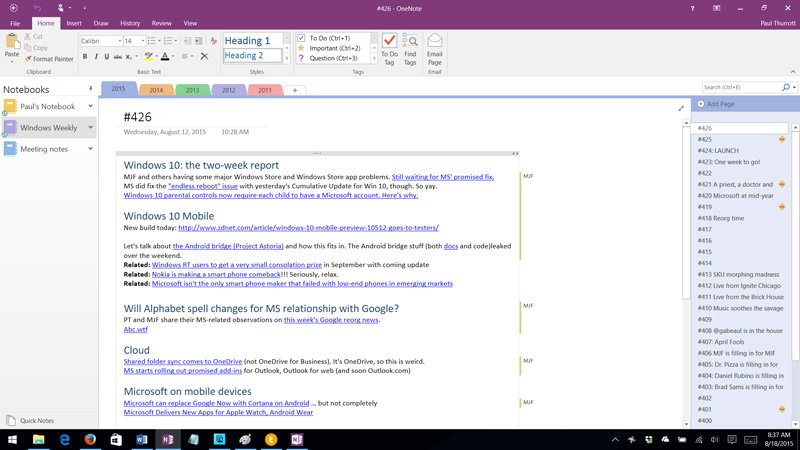Productivity Sauce
We have listed 10 Linux TreePad alternatives which includes commercial, freemium, free and open source options. KeepNote is a note taking application that works. As an Evernote alternative, ProofHub Notes lets you capture your ideas, random thoughts, finalized plans, and all other important project information so that you don’t have to remember everything. Bring all your notes and documents together at a central place with ProofHub Notes. Try ProofHub Notes now! Popular Alternatives to KeepNote for Windows, Mac, Linux, Web, iPad and more.
- There are more than 100 alternatives to KeepNote for a variety of platforms, including Windows, Mac, Linux, Android and iPhone. The best alternative is Microsoft OneNote, which is free. Other great apps like KeepNote are Evernote (Freemium), CherryTree (Free, Open Source), Zim (Free, Open Source) and NoteLedge (Paid).
- KeepNote is a note-taking and organization. KeepNote is a note taking application that works on Windows, Linux, and MacOS X. Developed by Matt Rasmussen License: Open Source.
NoteCase has always been an indispensable application in my productivity toolbox. So the news that NoteCase's developer ceased its development sent me scrambling for a replacement for this excellent note-taking tool. It didn't take me long, though, to discover KeepNote. Similar to NoteCase, KeepNote is a hierarchical note manager, which means notes in the application are organized in notebooks and subnotebooks that act as nodes in an hierarchical tree. You can assign different icons to each notebook and note (or page, in KeeNote's terminology), which makes it easier to identify and find specific pages and folders.

As you would expect from a note-taking application, KeepNote supports different text formatting options, including bold, italics, underlined, and monospaced. Using the available tools, you can also tweak font properties, apply different text and background colors, and choose between several text alignment options. Like any note-taking application worth its salt, KeepNote lets you insert links and images. In addition to that, KeepNote features its own screenshot tool. Choose Edit -> Insert Screenshot (or press Ctrl+Insert), and you can take a screenshot of any currently opened window. KeepNote then automatically inserts the screenshot into the currently opened note. Other nice touches include an integrated spell-check with automatic in-line spell check and a search feature that allows you to search the current page or all existing notes. All pages in KeepNote are stored in the HTML format, and you can view them in the browser or edit them in an external editor. The only missing feature here is the lack of import and export functionality and the ability to encrypt notebooks. There is, however, the Backup Notebook feature that can save the currently selected notebook as a tar.gz archive.
All in all, while KeepNote is still missing a few features some users might consider important, it already provides a viable alternative to the now-defunct NoteCase.
Comments
Keepnote not stable
Update your Linux distribution or try to run Keepnote on a different PC at home or work: You can never be sure to have keepnote still available. It seg-faults or behaves strange. It depends too much in odd libraries and packets. Python based applications are low-availability apps in this sense.
This is a perfect no-go for the storage of important information I want to access in one year on the system I run in one year. I'm forced to stay with ugly notecase.use Zim
I use Zim in my daily work, and is great: (http://zim-wiki.org/). It does the work of gnotes, and adds much other goodiesNoteCase Pro Available
Why not consider NoteCase Pro?
Yes, I know it costs money...but it's available, cross-platform, and supported with recent new release..has more features than NoteCase...
Also, NoteCase is still available, just not supported by developer....
Anyway, just curious....the only missing feature here is ..
Without the chance, to save a file with a password, there is no alternative solution for NoteCase! What a bummer!
Let's face it, no-one really likes shelling out for big-brand software like Microsoft Office, Adobe Creative Suite and so on yet sometimes we are forced to owing to the advantages that these software suites offer over alternatives. And let's face it, it can really add to the cost of a computer: once you've bought the thing in the first place you've then got to probably spend another $500 or so simply on software.
Thankfully, there are alternatives and in this article, I'm going to show you 10 free alternatives to popular applications that do (pretty much) the same as their commercial counterpart.
1. Office suite
- Commercial software: Microsoft Office, iWork
- Free alternative:LibreOffice
Unfortunately, your computer really isn't a computer without Microsoft Office and it has become a necessity in almost all fields of life. Yet depending on the version you choose, Office can set you back anywhere from $90 to $370 which, for some people, can be quite an expensive burden to bear. However, there is a great free office suite called LibreOffice, which is descended from OpenOffice. Although it won't provide you with the exact same feature set as Office, it does come in pretty close for mimicking functionality.
LibreOffice includes a word processor (Writer), spreadsheet (Calc), graphics editor (Draw), presentation program (Impress), database management program (Base) and math formula writer (Math) and is designed to be compatible with other office suites such as Microsoft Office, however when importing files and folders some formatting features can get lost on occasion. The suite also benefits from active support (it's open-source, after all) and you'd be surprised what you can do with it. Best of all, it's free and works across all platforms.
- Platforms: Windows, OS X and Linux
- Download link:LibreOffice
2. Email client
- Commercial software: Microsoft Outlook, Postbox
- Free alternative: Mozilla Thunderbird
Mozilla Thunderbird is really the uncontested free e-mail client, mostly due to its wide range of features and open-source properties and there's plenty worth shouting about. Thunderbird supports pretty much every single type of mail protocol (including Microsoft Exchange through an extension) and comes with plenty of stuff to play around with, such as tabbed e-mail, a one-click address book (so you can add new contacts easily) and loads of different extensions and add-ons (which are all free).
There are also other benefits of using Thunderbird, such as built-in chat support (in the latest version – 17), a news reader and a calendar application through the Lightning extension (which is also compatible with fruux and allows you to easily sync your calendars, by the way!). Thunderbird is cross-platform and can be installed on virtually any computer, no matter how old.
- Platforms: Windows, OS X and Linux
- Download link:Mozilla Thunderbird
3. GTD (Get Things Done)
- Commercial software: ThinkingRock, OmniFocus, Things
- Free alternative: Wunderlist
We featured Wunderlist in our OS X productivity roundup and it's making another appearance here, simply because of its usefulness as a free task manager. With Wunderlist, you can create and share lists of tasks with other people really easily.
However, the real beauty about this app is its design and simplicity – adding and managing tasks is a real breeze and you don't have to spend time learning how to use it, making it a real winner. Wunderlist is available in a standalone client for both Windows, OS X and Linux (as well as most smartphones) and there's a web version as well for adding notes and tasks when you're not at your computer.If you are into open standards, you might also be interested in another great way to keep track of your tasks and share your task lists with other people which we've covered a while ago.
- Platforms: Windows, OS X and Linux
- Download link:Wunderlist

4. Personal finance
- Commercial software: Microsoft Money, Quicken, Moneydance
- Free alternative: GNUCash
Why pay money for software to manage your money when you can get it for free? That's my opinion anyway – and the best way to manage your money for free is through GNUCash, an open-source personal finance manager. Although it won't win any awards for looks, GNUCash has plenty of built-in features worth shouting about, such as a checkbook style register with support for split transactions, marking transactions as cleared or reconciled and a summary bar that displays all of your account's information.
You can also set up scheduled transactions (and the app will remind you when one is due) and GNUCash can also report on your finances in either bar, pie or scatter chart form. There's also support for small businesses in there as well, with features such as profit and loss statements, portfolio management and online stock and share prices. Best of all, it's 100% open-source and available across all platforms.
- Platforms: Windows, OS X and Linux
- Download link:GNUCash
5. Photo editing
- Commercial software: Adobe Photoshop, Pixelmator
- Free alternative: GIMP
Linux users will already be familiar with GIMP, that wonderful little image tool that comes bundled in with pretty much every single distribution. It is mainly aimed towards photo editing, however you can also use GIMP to touch up images, draw in freeform, resize and crop images and convert image formats, alongside others. With a separate plug-in, you can also create animated images in both GIF and MPEG format.
GIMP is often cited as a free alternative to Photoshop, and it's pretty clear to see why. There is so much flexibility that can be achieved with the program, and although it takes a bit of getting used to at the start, it's well worth it in the end. GIMP is primarily an open-source program and there are native builds for Windows, OS X and Linux. There are also several spinoffs which aim to extend its functionality or provide a more native experience on certain operating systems, however I would personally recommend going for the bog-standard version.

- Platforms: Windows, OS X and Linux
- Download link:GIMP
6. Audio editing
- Commercial software: Adobe Audition, Logic Pro, Cubase
- Free alternative: Audacity

Audacity really is one of my favourite free programs on my Mac, and can be used for a huge range of uses, from simple audio editing to multitrack mixing and noise removal. I find myself using it quite a lot to digitally edit my music (splitting songs, removing hiss etc) and for a free, open-source program, it's got a fancy range of features. Audacity supports many different audio formats, including WAV, AIFF, MP3 (via a separate encoder), Ogg Vorbis and AAC and displays your track in a convenient waveform, allowing for precise editing.
Using Audacity you can apply many different effects to your songs and it also supports multitrack editing, even in a simple interface and I find it much easier to use than some of the commercial options out there on the market, such as Adobe Audition. Even if you don't want to use it to tinker with your music, it's worth its weight in gold when it comes to converting music formats and helps steer you away from the commercial (and sometimes expensive) audio converters out there on the market.
- Platforms: Windows, OS X and Linux
- Download link:Audacity
7. Note-taking
- Commercial software: Microsoft OneNote, Circus Ponies Notebook
- Free alternative: KeepNote
Keepnote App Alternatives
I tried to steer away from Evernote as although strictly speaking it's a note-taking application (and a very good one at that), it doesn't (in my opinion) replicate the functionality of a standalone note taking application on your computer. KeepNote, however, does. It's a nice, simple note taking client that supports rich text formatting, images, file attachments, spellchecking and sports a nice, hierarchical organisation interface for notes.
KeepNote also saves at regular intervals, so if it crashes then you haven't lost all your work and can also archive all your notes in a ZIP file. There is also added functionality through a range of extensions and the app is completely open-source (developers can grab the code from here) and available across all platforms.
- Platforms: Windows, OS X and Linux
- Download link:KeepNote
8. Virtualisation software
- Commercial software: VMWare Workstation/Fusion, Parallels Desktop
- Free alternative: VirtualBox
If you want to try out a new operating system (say, Linux) without running the risk of screwing up your computer, then your best bet is to run it virtually. VirtualBox is a free virtualisation software from Oracle which supports most Windows versions (no word on Windows 8 support, yet), a wide range of Linux distributions, Solaris/OpenSolaris, OS/2 and OpenBSD.
Although it won't give you as fluid an experience as commercial virtualisation software options will, it will still allow you to seamlessly run an operating system virtually. Make sure you've got a pretty powerful computer before installing, though, as running an entire operating system virtually can hog system resources massively…
- Platforms: Windows, OS X, Linux and Solaris
- Download link:VirtualBox
9. Concept mapping
- Commercial software: Microsoft Visio, OmniGraffle
- Free alternative: Dia
Dia is a great, free open-source concept mapping and drawing program with a wide variety of uses. You can use it to brainstorm and mind map, as well as create diagrams for business or personal use (such as flowcharts). Through their shape repository, you can also download a range of additional symbols for special uses (such as electronics symbols or chemistry).
Dia has been tested successfully on most Windows versions (no word on whether it works under Windows 8 as of yet) and OS X Snow Leopard, Lion and Mountain Lion (you'll have to have X11 installed in one way or another – xQuartz is usually a good bet). There are also versions for Ubuntu and openSUSE (the source files are also available as well)
- Platforms: Windows, OS X and Linux
- Download link:Dia
10. Desktop publishing
- Commercial software: Adobe InDesign, Microsoft Publisher, QuarkXPress
- Free alternative: Scribus
Scribus is a professional (and more importantly, free) desktop publishing software that is designed for layout and typesetting. You can also use it to create animated and interactive PDF presentations and forms as well, and the possibilities with it are endless – users have created a wide range of newspapers, brochures, newsletters, posters and books with the software. Scribus supports most major image formats (including Adobe Photoshop's .psd format) and vector drawings, which can either be imported directly into the app or opened for editing.
Unfortunately, there's no support for opening files created in other desktop publishing software, such as QuarkXPress and Microsoft Publisher however text can be imported into Scribus from a variety of formats, including OpenOffice, Microsoft Office and HTML. There's also no support for Pantone colour matching (due to possible legal repercussions) however there are workarounds. For a free program, Scribus does pack a pretty mighty punch and if you are looking to start out in desktop publishing (or simply fancy a change from a commercial piece of software), then it is a pretty safe bet.
- Platforms: Windows, OS X and Linux
- Download link:Scribus
Great software doesn't have to cost the earth…
The aim of this article was really to show you that great software doesn't have to cost the earth: there are plenty of other great (and less-known) alternatives to expensive pieces of commercial software out there. It's also worth noting that most of the free software contained in this little roundup is also open-source, which we here at fruux love and you should too!

With open-source, there is a much more active developer community, as anyone can download the code and have a play around with it. Because of this, open-source software often benefits from more frequent software updates, which ultimately benefits you as the consumer most as you get the most up-to-date stuff quickly!
And of course, if you're looking for an alternative synchronisation software, then why not try fruux out? Our system is based on open standards such as CardDAV and CalDAV and we can keep all your contacts, calendars and tasks in sync across all your devices, no matter which one you are using. Our Basic account is completely free and allows you to sync up to 3 devices with each other. You can also share calendars easily with anyone – straight from your Dashboard. To sign up for a free account, head over here.
Keepnote Alternatives
If you like this article then why not share it among your friends? And if you've got any questions about it, then just drop me an e-mail – my address is below :)